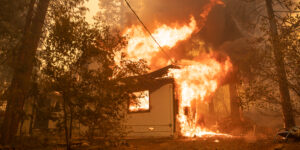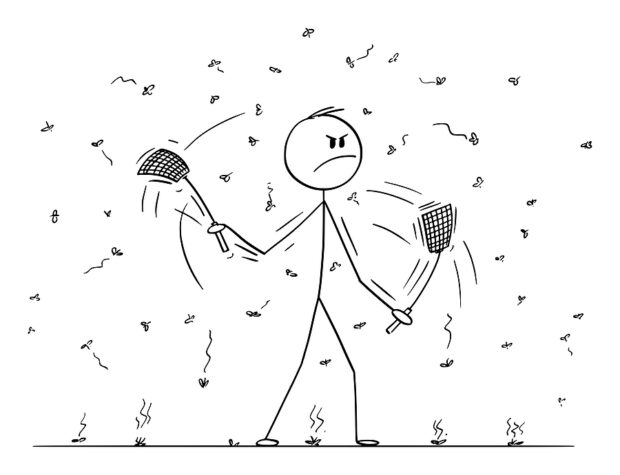By the time Martin DuPain got back home from a short walk last Thursday afternoon, he was covered with a smattering of tiny flying critters. They were in his hair, on his shirt and in his nose.
When he sneezed, the bugs came flying out.
As if the smoke and haze sweeping in from wildfires in Canada weren’t enough, New York City has been invaded in recent days with plumes of flying insects that have become both a nuisance and a source of fascination—what were they, where’d they come from and will they ever go away? Another unwanted Canadian export?
At first, DuPain, who lives in Queens, thought it might have been wind-driven ash, but he soon found out otherwise. Some were alive and flying. He quickly jumped in the shower.
The startling scene was nothing short of a “gnatural disaster,” quipped a post on Twitter, which has been abuzz with reports of swarms in some neighborhoods, while others remain bug-free.
As they entered clouds of bugs, some people tried to wave them away. Others covered their mouths and noses. Others put on surgical masks before venturing outdoors.
Professor David Lohman, an entomologist at the City University of New York, hadn’t seen any of the insects himself, but he concluded from photos and videos circulating on social media that they were winged aphids— not gnats, as amateur bugologists assumed.
Aphids are common all over the United States, even in New York City. They are small, pear-shaped insects that come in a variety of colors, from green, red and yellow to black, brown and gray.
While he is not an aphid expert—there are very few—Lohman said the swarms are unusual, given that aphids don’t usually come out in New York City until after summer. He theorized that warm winter temps might have contributed by causing the bug’s biological clock to go off-kilter.
On Friday, Lohman went in search of aphid experts who could chime in.
”Aphids fly at all times of the growing season,” Natalie Hernandez, who specializes in aphids, wrote in an email to Lohman. “If a colony gets too large, too dense, it will produce winged morphs to disperse.”
The wildfires in Canada and extreme temperatures ”could be messing with them too, ” she added.
That theory sounded plausible to Andy Jensen, another aphid researcher.
“The smoke might be allowing aphids to remain abundant longer into summer than normal,” Jensen said. ”Many aphids slow down or stop reproduction in the heat of summer.”
Whatever the cause, the city’s Public Health Department said, there was nothing to be alarmed about.
“While this may be annoying, these insects do not present a known public health risk,” the department said in a statement Friday. “We are looking into these bugs and will share any important health information.”
The bug experts say the swarms shouldn’t last much longer, which is a relief to Jeremy Cohen, who was riding his bike in Brooklyn when he felt as if he was being pelted by bits of hail.
At times, he steered his bicycle with one hand and used the other to cup his mouth and nose.
“I knew the air quality was bad so I just assumed it was debris from the wildfires just flying around – which I thought would have been crazy,” said Cohen, a professional photographer. “Then I slowly realized there was a swarm of bugs flying around.”
While some saw the insects as annoying, the presence of so many bugs delighted Lohman.
“The appearance of all these aphids signal something great: New York is organic! ” he said. ”If pesticide use was widespread, there wouldn’t be this many aphids. “





















 InsurTech Profile: Optimalex’s AI Tools ‘Co-Pilot’ Alongside Human Expertise
InsurTech Profile: Optimalex’s AI Tools ‘Co-Pilot’ Alongside Human Expertise  P/C Insurance Execs, Underwriters Out of Sync on Advanced Tech
P/C Insurance Execs, Underwriters Out of Sync on Advanced Tech  The Supreme Court Just Complicated Employer Diversity Initiatives
The Supreme Court Just Complicated Employer Diversity Initiatives  Progressive Gains as Drivers Shop Around for Auto Insurance—Again
Progressive Gains as Drivers Shop Around for Auto Insurance—Again 



